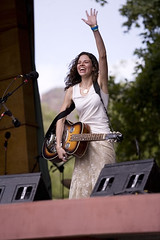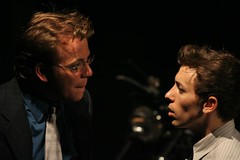Delbert McClinton is one of those singers who make everything look easy. His buttery voice seems to issue from his smiling lips and fill a concert hall with no effort. He’s followed up his initial push – courtesy of John Belushi and Saturday Night Live – and his 1980 top ten hit “Givin’ It Up For Your Love” with an indefatigable touring career, interpreting great blues, soul, R&B and lounge tunes all over the universe and becoming a noted songwriter as well.
This DVD, issued by McClinton’s label, New West, captures a 1982 Austin City Limits performance by Delbert and a tight nine-piece band. The outfits and haircuts are amusingly dated, the rather stodgy camera work a little less amusingly so – but then, they shot things more simply in those days. ACL was (and is) essentially “just” a TV show. The deep, crystalline sound of the original recording process is the main thing.
The price is modest, so the lack of extras shouldn’t be a deal-breaker for fans, but it is a little disappointing, especially since McClinton has remained very active in the new century, with a new CD and an important part in an upcoming documentary.
Highlights include a funky “Shaky Ground,” a sweet and slow “Jealous Kind,” the Texas swing of “Lipstick, Powder and Paint,” and of course “Givin’ It Up.” Casual or new fans will be interested in McClinton’s treatment of “Take Me to the River,” “Turn On Your Love Light,” and the Otis Redding chestnut “I’ve Got Dreams to Remember.”
Moving from a smooth-as-a-baby master of interpretation to a stage-awkward and unabashedly goofy songwriting genius: the altogether more rough-hewn John Hiatt hit the ACL stage eleven years later. (Note for theme junkies: if you haven’t heard McClinton’s version of Hiatt’s “Have a Little Faith In Me”, one of the most beautiful songs ever written, you really ought to.) Anyway, for Hiatt in 1993 theACL set is lit, and the concert shot, more artfully, while Hiatt’s soul patch and bassist Davey Faragher’s swinging dreads confirm that we’ve pushed ahead into the grunge era of the nineties.
Well before this time, however, Hiatt had succeeded in amalgamating his country, blues and rock strains into a pure, timeless form of songwriting that works anywhere and anywhen. One welcome aspect of this concert is its inclusion of a batch of excellent songs Hiatt hasn’t been performing lately. It’s great to have rocking live versions of “Buffalo River Home,” “When You Hold Me Tight,” “Angel,” “Something Wild,” and “Straight Outta Time,” all from the Perfectly Good Guitar album, which had just been released, and none of which appear on the excellent live CD Hiatt Comes Alive at Budokan? which came out the following year with the same band.
Have no fear, though: you also get the better-known “Memphis in the Meantime,” “Have a Little Faith In Me,” “Thing Called Love” (which Bonnie Raitt made famous), “Tennessee Plates” and “Slow Turning.” The only thing I thought could have been better was Hiatt’s solo rendition of “Icy Blue Heart,” which opens the concert. Some of the song’s aching beauty is lost at the speedy tempo he gives it here.
Faragher, who handles most of the backing vocals, was and is one of the best bass players working. Here he locks perfectly with drummer Michael Urbano, his former Cracker batterymate, while Michael Ward (from School of Fish), handles lead and rhythm guitar with guts and gusto, unimpeded by his giant grunge-shorts (or are they man-capris?). Hiatt’s own guitar playing, like his singing, seems lifted straight out of the dirt of ages.
As with the McClinton disc, there are no extras. These are pure concert videos, remixed and remastered. However, since the shows were originally edited down to fit the ACL half-hour format, the discs in the series contain much previously unreleased material. (I also have the Richard Thompson disc, which I’ll write about in a future column.)
Format: DVD Stereo / DTS
Video: Good
Sound: Very Good
Extras: None


